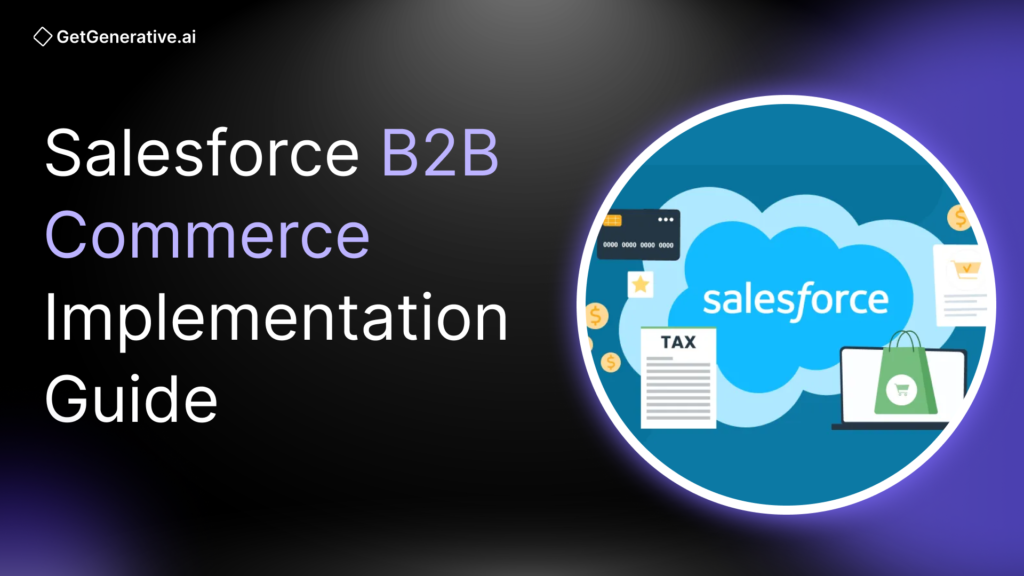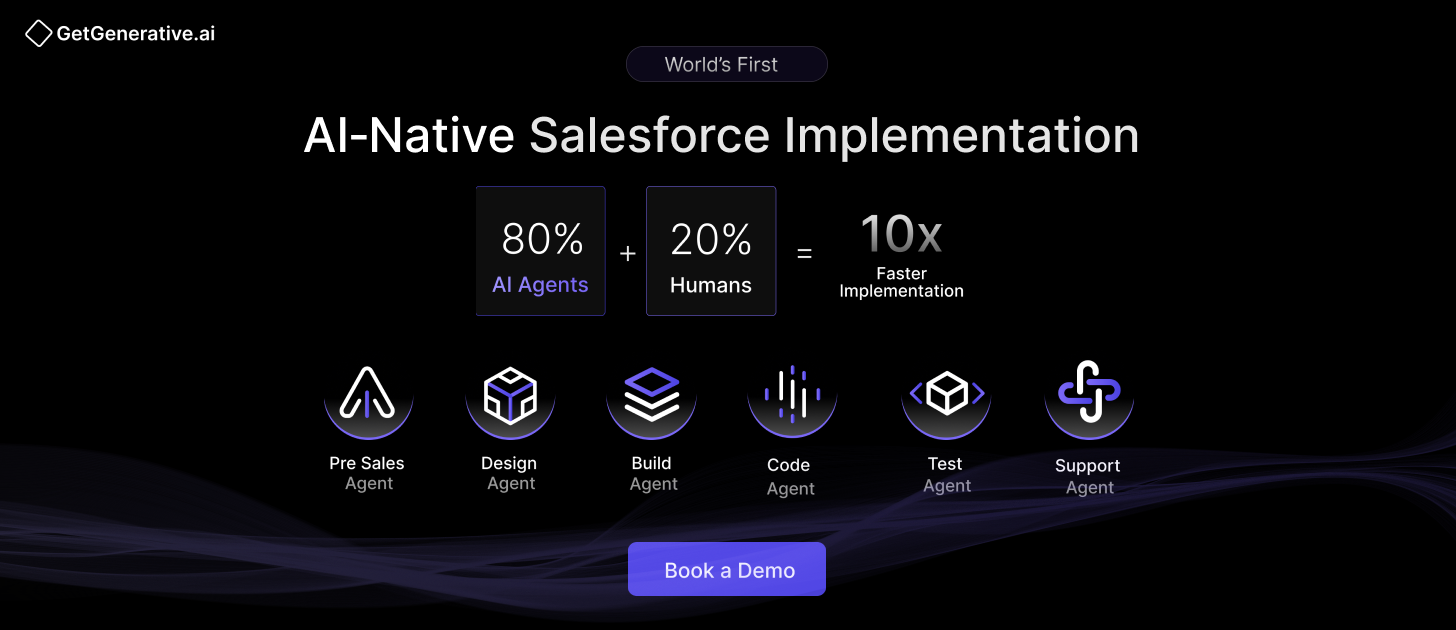Salesforce B2B Commerce Implementation Guide 2025
An overwhelming majority—four out of five—of B2B purchasers are now using their smartphones and tablets during work hours to conduct research and make purchases. These buyers leverage approximately 10 different sales channels when gathering information about products or services. While this number has not changed significantly over the past several years, a discernible trend towards mobile-centric channels indicates a growing preference for mobile platforms in the B2B buying process.
In this blog post, we will explore Salesforce B2B Commerce implementation’s features, benefits, and best practices. Whether you’re a business looking to establish your online presence or optimize your existing B2B e-commerce operations, this comprehensive guide will provide valuable insights and actionable tips to help you succeed in the digital marketplace.
What is Salesforce B2B Commerce?
Salesforce B2B Commerce is a robust, cloud-based e-commerce solution designed to meet business-to-business (B2B) companies’ unique needs. Built on the Salesforce platform, it empowers businesses to create and manage their online stores, streamline complex B2B selling processes, and deliver a seamless, personalized customer buying experience.
Core Features and Capabilities
1. Rich Product Catalog Management
Publish detailed, multimedia-enhanced product catalogs—ideal for industries where buyers need specs, CAD files, and in-depth product data before purchasing.
2. Automated Order Management
Commerce Cloud streamlines complex order processes—approval workflows, quote-to-order flows, renewals—and integrates directly with ERP and inventory systems.
3. Account-Based Pricing & Quoting
Negotiate pricing by customer or contract. The pricing engine supports volume discounts, contract-specific terms, and bulk orders. Quotes can be auto-generated and converted directly into orders.
4. Customer Self-Service Portal
Enable 24/7 self-service ordering, tracking, and invoice viewing—reducing manual support overhead while improving satisfaction.
5. AI Personalization with Einstein
Deliver Amazon-like personalization using Einstein for search, product recommendations, and predictive buying behavior based on past data.
6. Global Commerce Capabilities
Support for multi-currency, multi-language, and multi-site operations. Salesforce guarantees enterprise-grade reliability with 99.99% uptime across 84+ countries and built-in compliance for PCI, GDPR, and HIPAA.
These features combine to create a robust, scalable platform capable of managing high-volume, high-value B2B transactions while providing exceptional buyer experiences.
Implementation Best Practices
To maximize ROI and minimize risks, companies should follow a phased, strategic approach to implementation.
1. Define Success Metrics Early
Set clear business goals—e.g., increase online sales by 30%, reduce manual orders by 50%, or shorten reorder time. Align every implementation phase with these KPIs.
2. Engage Cross-Functional Teams
Involve Sales, Marketing, IT, Customer Support, and Operations from day one. Shared ownership fosters alignment and avoids late-stage friction.
3. Build a Strong Business Case
Justify investment by comparing projected revenue growth, operational savings, and cost-to-serve reduction against platform and implementation costs. Reference ROI benchmarks and third-party research from Salesforce or Forrester.
4. Audit and Cleanse Data
Structured product, pricing, and customer data is foundational. Clean, deduplicated master data accelerates time-to-value and ensures seamless system behavior.
“Everything shown to the customer—products, prices, catalogs—is driven by data. Get your data right early,” says a Salesforce implementation expert.
5. Integrate ERP & Back-End Systems Early
Don’t leave integrations for last. Prioritize syncing pricing, inventory, and product data via sandbox environments. Use MuleSoft or similar middleware to streamline.
6. Use Out-of-the-Box Features First
Prioritize Experience Builder templates and native functionality to minimize custom code and simplify maintenance.
7. Launch in Phases
Start with an MVP storefront featuring core ordering and account tools. Add mobile, AI personalization, or global sites in future releases.
8. Prioritize UX and Mobile Optimization
Design intuitive, fast-loading storefronts. Implement faceted search, one-click reordering, and mobile responsiveness using Agentforce chat and native Salesforce UI tools.
9. Plan for Security & Compliance
Use Salesforce’s native compliance tools, set up role-based access, and implement region-specific tax, privacy, and data handling policies as required.
10. Train and Communicate
Prepare training sessions, quick guides, and onboarding materials for internal users and external customers. Early communication drives adoption and feedback loops.
By following these proven practices, companies can avoid common pitfalls like integration delays, data issues, and poor adoption.
Related Read – Salesforce Implementation With AI – The Ultimate Guide
Common Implementation Challenges—and How to Overcome Them
Even with a solid platform like Salesforce B2B Commerce Cloud, implementations can run into predictable roadblocks. Being proactive and addressing these challenges early is essential to stay on time and on budget.
Data Quality & Migration Issues
Many B2B businesses have outdated, inconsistent product and customer data. This leads to errors in catalogs, pricing mismatches, and customer frustration.
Solution:
Perform a full data audit before implementation. Use Salesforce Data Loader or MuleSoft for migration and validate the data in sandbox environments before production deployment.
Complex Pricing Rules
Negotiated contracts, regional pricing, and volume discounts make B2B pricing inherently complex. Without clear structure, these rules become hard to automate.
Solution:
Break pricing into logical segments—by region, tier, or contract type—and model them using Salesforce’s account-level price books and discount schedules. Test these thoroughly across scenarios.
Legacy System Integration
Connecting on-premise ERP, PIM, or accounting systems to Salesforce can involve significant effort, especially if data formats are inconsistent or APIs are unavailable.
Solution:
Involve IT teams early. Use MuleSoft or pre-built connectors. When custom integrations are required, ensure modular, API-first architecture for long-term flexibility.
User Resistance to Change
Sales reps or long-standing customers might be hesitant to adopt a digital platform.
Solution:
Engage power users in pilot programs. Offer training and demonstrate tangible benefits (e.g. faster reorders, real-time order status). Gamify adoption for internal teams.
Over-Customization Risks
Extensive custom development can break during Salesforce upgrades and drive up long-term costs.
Solution:
Use Salesforce’s native capabilities and Experience Builder where possible. When custom work is necessary, document thoroughly and modularize it using Lightning Web Components or managed packages.
Performance Under Load
High-traffic periods can expose bottlenecks in your site performance.
Solution:
Leverage Salesforce’s auto-scaling infrastructure. Use load testing tools like JMeter to stress test the site and optimize front-end performance (image compression, lazy loading, caching).
Regulatory Compliance
Companies operating globally must comply with local data residency, tax, and privacy regulations.
Solution:
Leverage Salesforce’s built-in GDPR and PCI-compliant framework. Set up country-specific rules for pricing, tax, and content, and work closely with legal/compliance teams during rollout.
“Nobody phrases it this way, but I think that artificial intelligence is almost a humanities discipline. It’s really an attempt to understand human intelligence and human cognition.”
– Sebastian Thrun, CEO of Kitty Hawk Corporation and Co-Founder of Udacity
Emerging Trends and Future Outlook for B2B E-commerce
The B2B e-commerce landscape is evolving rapidly, driven by technological advancements and changing buyer expectations. Businesses need to stay ahead of these trends to maintain a competitive edge. Here are some key trends shaping the future of B2B e-commerce:
- AI-Powered Personalization
Artificial intelligence and machine learning are becoming central to delivering hyper-personalized experiences. AI can analyze customer behavior, predict purchasing patterns, and recommend products tailored to individual preferences, enhancing engagement and conversion rates. - Voice Commerce
With the growing adoption of voice assistants like Alexa and Google Assistant, voice search and commerce are becoming vital. B2B platforms may need to optimize for voice search and enable voice-based transactions to stay relevant. - Sustainability in E-commerce
Eco-conscious buyers are influencing businesses to adopt sustainable practices. Expect a rise in green supply chains, recyclable packaging options, and platforms highlighting sustainability credentials. - Advanced Analytics and Predictive Insights
Data-driven decision-making will be critical. B2B e-commerce platforms will increasingly rely on advanced analytics to predict market trends, optimize inventory, and enhance customer experiences. - B2B Marketplaces and Collaborative Commerce
The growth of B2B marketplaces offers businesses a centralized hub for selling products and services. Collaborative commerce models are also emerging, allowing suppliers and buyers to co-create value. - Blockchain for Transparency and Trust
Blockchain technology is set to revolutionize B2B e-commerce by ensuring transparency in transactions, reducing fraud, and improving traceability in the supply chain. - Enhanced Mobile Experiences
With a significant portion of B2B buyers using mobile devices, optimizing for mobile-first experiences, including fast-loading sites and easy navigation, will be non-negotiable.
Related Read – Salesforce CRM Implementation With AI – The Ultimate Guide
Conclusion
Implementing Salesforce B2B Commerce can revolutionize businesses’ operations, providing a powerful and scalable platform for managing online sales and customer relationships. By following best practices, customizing the platform to meet needs, and integrating it with other systems like ERP and CRM, businesses can create a seamless and efficient e-commerce ecosystem that drives growth and success in the digital age.
If you’re looking for help with Salesforce implementation, explore our AI Salesforce Consulting Services for expert guidance tailored to your business.
Frequently Asked Questions (FAQs)
1. What is Salesforce B2B Commerce, and how does it differ from other e-commerce platforms?
Salesforce B2B Commerce is a cloud-based e-commerce solution for business-to-business (B2B) companies. Unlike traditional e-commerce platforms primarily focused on B2C (business-to-consumer) selling, Salesforce B2B Commerce offers features tailored to the unique needs of B2B businesses, such as complex pricing structures, personalized catalogs, and self-service account management.
2. Can Salesforce B2B Commerce integrate with my existing ERP or CRM systems?
Yes, Salesforce B2B Commerce can be integrated with various ERP and CRM systems, including Salesforce’s Sales Cloud (CRM) and other third-party solutions. Integration allows for seamless data synchronization, streamlined processes, and a holistic view of your customers across all touchpoints.
3. How customizable is the Salesforce B2B Commerce platform?
Salesforce B2B Commerce is highly customizable, allowing businesses to tailor the look and feel of their online store to match their brand identity. The platform offers a range of customization options, including theme editing, custom CSS, and the ability to create custom pages and components using Salesforce’s Lightning Web Components framework.
4. Can Salesforce B2B Commerce handle complex pricing and ordering scenarios?
Salesforce B2B Commerce is designed to handle complex B2B pricing and ordering scenarios. The platform supports tiered pricing, volume discounts, contract-based pricing, quote management, and bulk ordering. It can also be integrated with CPQ (Configure, Price, Quote) solutions for even more advanced pricing and quoting capabilities.
5. How does Salesforce B2B Commerce support personalized experiences for customers?
Salesforce B2B Commerce enables businesses to create personalized experiences for their customers through features like customer-specific pricing, custom catalogs, and personalized product recommendations based on a customer’s purchase history or account profile. The platform’s integration capabilities also allow for leveraging customer data from CRM and other systems to personalize the buying experience further.




